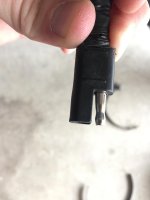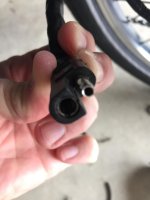You are using an out of date browser. It may not display this or other websites correctly.
You should upgrade or use an alternative browser.
You should upgrade or use an alternative browser.
Can water bottle battery packs be wired up in parallel?
- Thread starter lameduck
- Start date
cal3thousand
10 MW
lameduck said:I have two of these batteries: http://www.electricbicycleworld.com/li-3/. Would it be possible to wire them in parallel to get longer range? If so, does it just require combining the + to + and - to - connections coming out of the battery packs?
If there are the exact same, yes.
tomjasz
1 GW
Too many problems to mess with IMO. Must be charged separately and must be, as said above, matched. Istall a switch or just make up some lead sand plugs and take one off line and plug in the other.
FWIW, paralleling them is a better idea than switching between them, if they are identical packs (same chemistry and number of series cells; doesn't matter about number of parallel cells). You only have to paralllel the output leads, though you can also parallel the charging leads if you have a charger with double current capability, or you don't mind it taking twice as long to charge (so it'll charge faster if you leave the charging leads unparalleled and use separate chargers for each, at the same time).
If you parallel the output leads (rather than switching between them) then you cut the load on each pack in half, which means the total pair can deliver twice the output current it could have if used singly, and/or it will run cooler, have less voltage sag, and so probably be able to take you farther under the same load than it would have if run singly.
If the packs are different chemistries, or different numbers of series cells, then the above may not be true/possible, depending on how close a match they are.
If you parallel the output leads (rather than switching between them) then you cut the load on each pack in half, which means the total pair can deliver twice the output current it could have if used singly, and/or it will run cooler, have less voltage sag, and so probably be able to take you farther under the same load than it would have if run singly.
If the packs are different chemistries, or different numbers of series cells, then the above may not be true/possible, depending on how close a match they are.
dogman dan
1 PW
Does not need to be matched entirely,,, DOES need to charge to, and be at, the same voltage when you connect up. I do this all the time, with a 13s 20 ah, and a 13s 13 ah pack. One pack is a year and a half older than the other, and totally different brand. No problems.
Yes,, unless you do some fancy wiring, you will need to unplug them to charge separately. Whoop de do.
You can run one pack, then run the other. Or you can parallel them for the whole ride. If your one pack is very adequate in size, there is little sag under load, then not a pressing reason to combine them for the ride.
But in most cases, you do have some very noticeable sag under load, and combining the packs results in a lot less. This sag is an indication that your cells are working hard,, and by combining the packs, you take the strain off your cells. This is Always good..
So go ahead and parallel those packs. All you need is a Y cable.
The exception, is the closed system batteries they talk about on that falco website. But others, you can just parallel them if they charge to the same voltage. Even different chemistries.
Yes,, unless you do some fancy wiring, you will need to unplug them to charge separately. Whoop de do.
You can run one pack, then run the other. Or you can parallel them for the whole ride. If your one pack is very adequate in size, there is little sag under load, then not a pressing reason to combine them for the ride.
But in most cases, you do have some very noticeable sag under load, and combining the packs results in a lot less. This sag is an indication that your cells are working hard,, and by combining the packs, you take the strain off your cells. This is Always good..
So go ahead and parallel those packs. All you need is a Y cable.
The exception, is the closed system batteries they talk about on that falco website. But others, you can just parallel them if they charge to the same voltage. Even different chemistries.
dogman dan
1 PW
First thing you do is determine the polarity of each wire, mark them, then cut those crap bullet connectors off.
VERY often,, the red wire on one side will be positive, but on the other side of the plug the red wire will be negative. So watch out for that polarity. This is one of the things that sucks about those bullet connectors.
Then replace with a better connector,, 4 mm bullets, andersons, whatever you like depending on if you prefer to solder or crimp. Make your y cables with 12g wire. Preferably the very flexy silicone wire from the RC places.
VERY often,, the red wire on one side will be positive, but on the other side of the plug the red wire will be negative. So watch out for that polarity. This is one of the things that sucks about those bullet connectors.
Then replace with a better connector,, 4 mm bullets, andersons, whatever you like depending on if you prefer to solder or crimp. Make your y cables with 12g wire. Preferably the very flexy silicone wire from the RC places.
Marin
1 kW
I just noticed on the grin site they have a pre made Y cable just for this application
Thanks all for the response. I am now thinking of replacing the bullet connectors with XT 60 connectors. Seems like checking the polarity for the battery leads will be easy enough with a multi meter. Do you check the motor polarity the same way? Using a multimeter and just connect the multi meter leads to the leads on the motor to see if the wires are - or +? (Sorry, very noob question)
tomjasz
1 GW
I'm sorry, this is a case of a xperienced builders suggesting a totally new rider take on a task that can be a problem. If I learned anything answering customer requests I learned to encourage baby steps for most new builders. You guys are smart but I think somedays forget how it was starting off and the really dumb mistakes you made with limited experience.
carry on...
carry on...
Similar threads
- Replies
- 4
- Views
- 287
- Replies
- 2
- Views
- 289
- Replies
- 1
- Views
- 902



